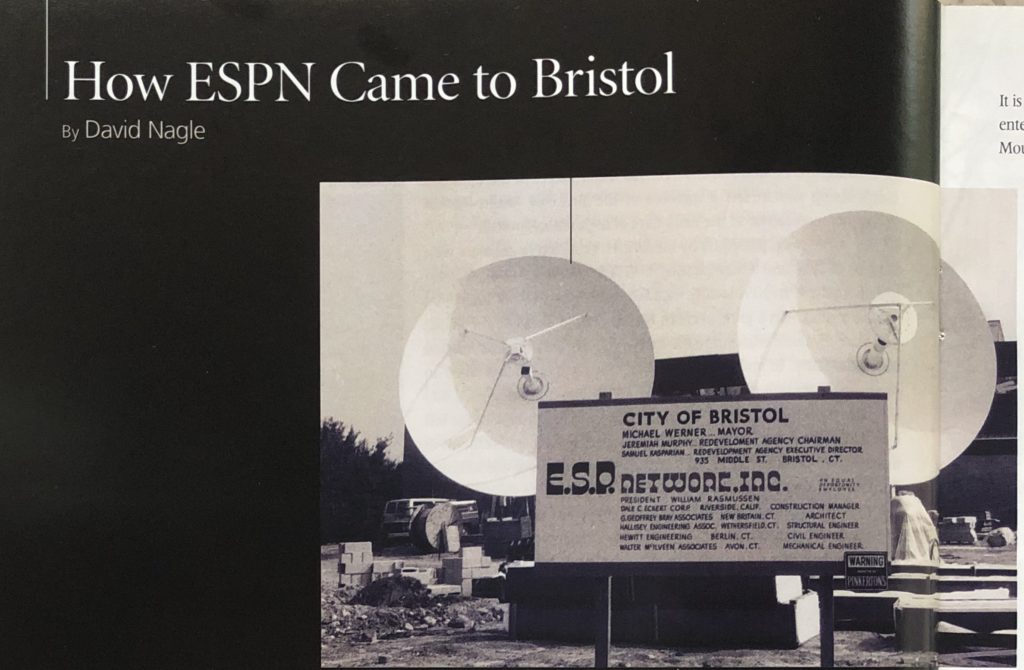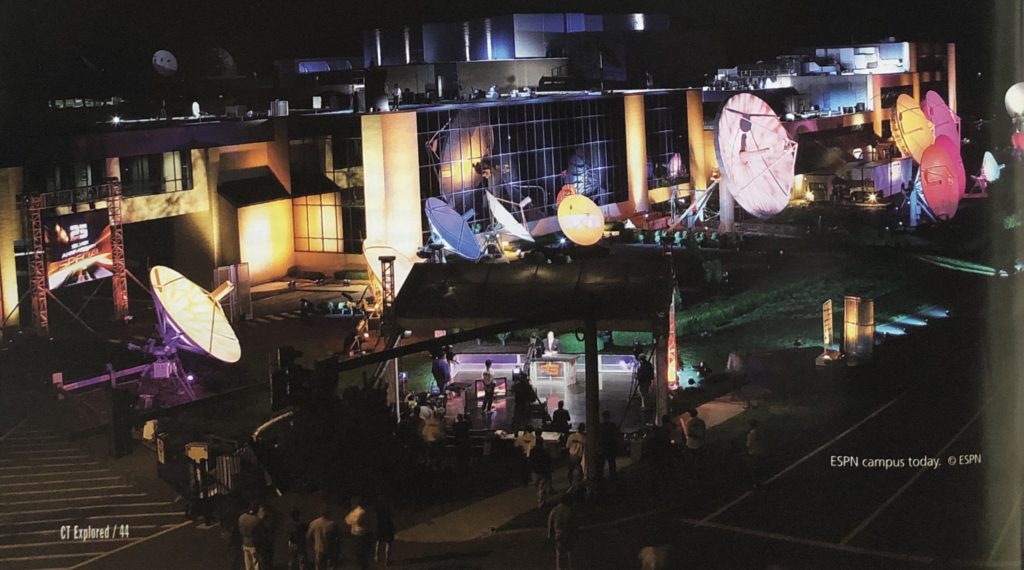By David Nagle
(c) Connecticut Explored Inc. Fall 2009
Subscribe/Buy the Issue!
It is hard to imagine that today’s leader in sports entertainment rose from the shadows of South Mountain in sleepy Bristol, Connecticut. That athletes and celebrities alike venture to this largely blue-collar New England town to make use of the company’s technological and creative expertise in sports programming and reach fans around the world via all manner of media is one of the state’s great success stories. Yet it was a plucky entrepreneur’s lucky – and improbable – selection of Bristol in 1978 as a place to implement his idea to create an all-sports TV network that spawned ESPN’s growth, and the company’s location has served as the foundation for its continuing success.
Today the ESPN (for Entertainment & Sports Programming Network, shortened to ESPN in 1985) campus in Bristol encompasses nearly 20 buildings totaling close to 750,000 square feet on more than 100 acres (actually stretching across the town line into Southington). From here emanate the familiar television and radio shows, much of the Web site, and all of the can-do spirit of a company that’s still young at heart in its 30th year. In an average week, 104 million Americans watch, listen, read or log on to ESPN-branded media. Beyond U.S. borders, 45 ESPN networks reach 200 million people on all seven continents. ESPN’s loyal fan base has expanded dramatically from the few souls who saw the first flickering images of the station’s debut, the initial airing of SportsCenter at 7 p.m. Eastern Standard Time on September 7, 1979. (That show’s still running, more than 30,000 editions later.)
So how does a worldwide conglomerate emerge from such a setting, once wilderness and open fields (home to the occasional cow), in a town that at one time was the clock-making capital of the world and still claims the nation’s oldest amusement park?
One Friday afternoon in August 1978, Bill Rasmussen, a former sportscaster and public relations director for the World Hockey Association’s New England Whalers, and his son Scott were stuck in traffic on Connecticut’s I-84. They were discussing possible programming for their newly acquired RCA satellite transponders, a new piece of broadcast technology they had leased after hearing about it and becoming intrigued. On a lark, Bill blurted out the idea to create a network devoted only to sports. Sports fans both, father and son instantly thought they had a great idea.
Rasmussen, a long-time Connecticut resident, began working out of Plainville, planning his start-up venture. He rented space from a small cable company but looked elsewhere for a permanent location for the studio and technical facilities. When asked why he didn’t choose Plainville to launch ESPN, Rasmussen replied, “Our landlord – United Cable – told us Plainville had an ordinance prohibiting satellite dishes of any kind.”
United Cable had recently purchased a small parcel of land on Bristol’s Middle Street. The cable company mentioned to Bristol officials that an outfit called the E.S.P. Network was looking for space and might be interested in the remaining Middle Street real estate. Rasmussen’s desire to find a suitable home for his project was so strong that he bought the land, which lay on the edge of town in the swampy corner of an industrial park, sight unseen.
ESPN’s planned cutting-edge use of satellites to receive and transmit signals demanded certain precise technical parameters. Satellite signals are very fragile and can be easily disrupted, so not just any piece of land would do. As luck would have it, the surrounding hills, and in particular South Mountain due west of Rasmussen’s property, protect ESPN’s satellite signals from damage or interference without being so high as to block reception and transmission.
After the purchase of the property, the planning, construction, and search for financing, programming, employees, and advertising occupied Rasmussen day and night until the curtain rose on the operation on September 7, 1979.
As ESPN has grown over the years – both physically, buying land adjoining the original parcel, and as a business, creating a brand known around the world – the city of Bristol has benefited both financially and in terms of recognition as the home of ESPN. John Leone, former Bristol mayor and now executive director of the Bristol Chamber of Commerce, views ESPN as a symbol of hard work and success for all the folks that call Bristol home.
“Bristol has gone from a mid-size city in New England known for its manufacturing base to the king of cable sports television, and home of ESPN, the world leader in sports,” says. “We can’t go anywhere in the world without someone asking about ESPN, when they know we live in Bristol.”
Bristol native Cheryl Therriault has been a first-hand witness to the company’s growth and the positive influence ESPN has had on the community. She was one of the company’s first hires 30 years ago and now has been an ESPN employee longer than anyone currently with the company. She also has been very active in the company’s TEAM ESPN corporate outreach efforts – which include everything from cleaning up neighborhoods to working with kids, the disabled, and the disadvantaged, “When I was hired at ESPN I had no idea what I was really getting into,” she admits. “I didn’t know much about sports and was told it didn’t really matter. They were looking for honest, energetic people to help launch a dream. There was lots of hard work, long hours, enthusiasm, dedication, and fun.”
Early on, Therriault found she had to do a lot of explaining what exactly ESPN was. Today the company’s human resources is inundated with resumes as hundreds of people fight for a chance to relocate to Bristol. “I can honestly say I am so proud to be part of this wonderful team and very glad I took the step into the unknown at that time,” Therriault says with pride. Her attitude reflects that of both Bristol as a whole and Rssmussen, who shared that history-making step into the unknown.
David Nagle is a 22-year veteran of ESPN’s communications department.
Explore!
Read more stories about products and inventions Made in Connecticut on out TOPICS page.
Read more Connecticut Sports History stories on our TOPICS page.


